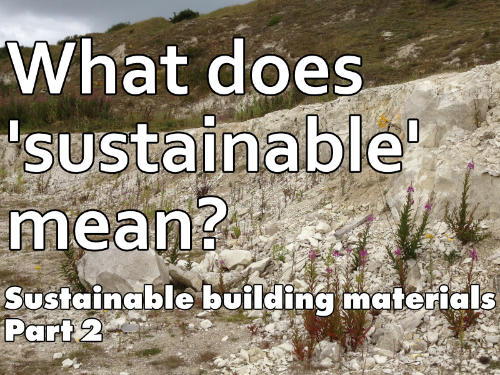What does 'sustainable' mean? Sustainable building materials, Part 2
Originally posted 3rd March 2020
Definitions of sustainability
In the last blog I talked about the term ‘natural’ in relation to buildings and sustainability, concluding that it was unhelpful at best, as it doesn’t really tell us anything about a product’s provenance, sustainability, or even level of processing (e.g. wood-fibre board and strawbale and are both described as ‘natural materials’ but neither would exist in their useful form without mechanised human intervention).
You can read that blog here: Natural vs Sustainable - Sustainable Building Materials, Part 1.
Today I’ll look at that other word I keep using: sustainable. What does that mean? What does it mean for material and construction choices? Ahead of that I should say that it affects a lot more than just your material choices, but I’ll write more about that in a later blog.
First up, back to the Oxford English Dictionary:
adjective
1. able to be maintained at a certain rate or level.
• conserving an ecological balance by avoiding depletion of natural resources.2. able to be upheld or defended.
Then there’s the oft-quoted and now classic definition of sustainable development from the United Nations World Commission on Environment and Development back in 1987:
meets the needs of the present without compromising the ability of future generations to meet their own needs
Essentially, all these definitions point towards consequences: being sure that the consequences of current actions neither have a negative effect on ourselves, on people younger than us, on people who haven’t been born yet - nor inflict ecological harm on the wider environment.
In terms of materials choices, that boils down to three main areas of concern:
Carbon emissions.
How much carbon dioxide (CO₂) and other gases with global warming potential are released in the production and use of a building material. Given the urgent and pressing need to reduce global CO₂ emissions, this is the overriding concern. But looking at CO₂ without considering resource depletion or ecological harm fails to comply with full definitions of sustainability above. CO₂ must be a prime consideration, but a holistic approach is needed. CO₂ and the other issues of sustainability. The vast scientific consensus is that failure to address carbon dioxide levels now has huge negative impacts for the future in the terms of the effects of climate change. These impacts are already being felt but what we do now determines how much worse they will get.Resource depletion.
Whatever we build with, we need to use it carefully, minimising waste both in manufacture and construction. Mineral resources are finite - if we exhaust them then clearly we “compromise the needs of future generations to meet their own needs.” We also need materials that are obtained efficiently. There are studies that suggest around 50% of all materials extraction is unused - i.e. it is the stuff removed to get at the things we do use.Bio-based (grown) building materials are not finite if more are grown, but still require some resource inputs, be that fertiliser or simply fuel-use in managing the crop, then harvesting and processing it. These inputs contribute to resource depletion. Finding materials based on crops that need minimal inputs is essential.
Planting alone is not a get-out clause though. Much harm can be done by planting the wrong thing in the wrong place, or by removing valuable ecosystems to plant a specific crop.
Any resource takes energy to extract and process, so the more of something we use, the greater the implications for CO₂ emissions. Additionally, as energy use increasingly relies on de-carbonised electricity, energy security demands that we use as little energy as possible in order to ensure there is sufficient energy available.
Ecological harm.
This is third in the list because both carbon emissions and resource depletion contribute to ecological harm, along with destruction of habitat, loss of biodiversity, and toxicity. Habitat and biodiversity can be lost directly through destruction in order to extract mineral resources, or through land-use change in order to plant particular crops. Toxicity can be an issue during mineral extraction (e.g potential for toxic pollutants to leach from quarries and mines etc.), processing (harmful bi-products of manufacture), and in use (off-gasing or leaching of potentially harmful chemicals).Bio-based materials don’t necessarily get a clean slate when it comes to toxicity either. For example, different crops may change the pH balance of soil in a way that effects the growth of other organisms, or the additional inputs of fertilisers or insecticides can cause pollution incidents if washed into water courses.
There are many factors and sub-factors involved (the above is just a summary) but in short: the search for sustainable building materials means finding materials with the least possible contribution to carbon dioxide emissions, resource depletion, and ecological harm. Actually assessing that can get more complicated again.
In coming blogs I’ll explore these issues using some examples of different building materials.
Meeting the needs of the present
For now I want draw attention to the words “meets the needs of the present” from the definitions of sustainability above. In the specific context of buildings, this has to mean buildings that are healthy to be in - that maintain thermal comfort, good internal air quality (and don’t degrade external air quality), with minimal energy input. It also means buildings that can continue to achieve this under any future future climatic conditions. This is why the growing use of passivhaus is so important - especially when constructed in a way that meets the criteria of sustainability above - as these are precisely the issues it addresses (more of that to come in future blogs).
Anything else is not sustainable.

